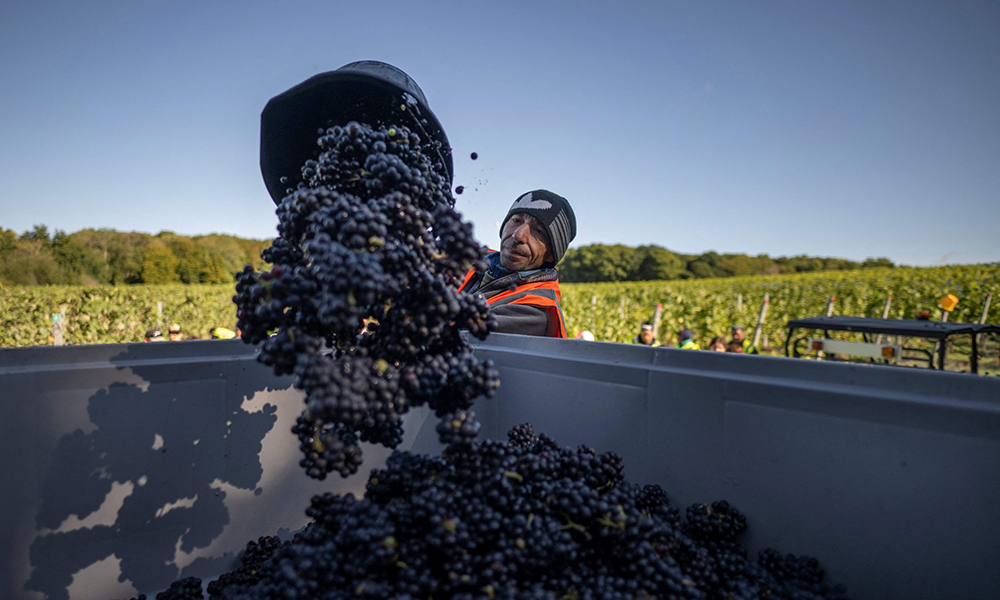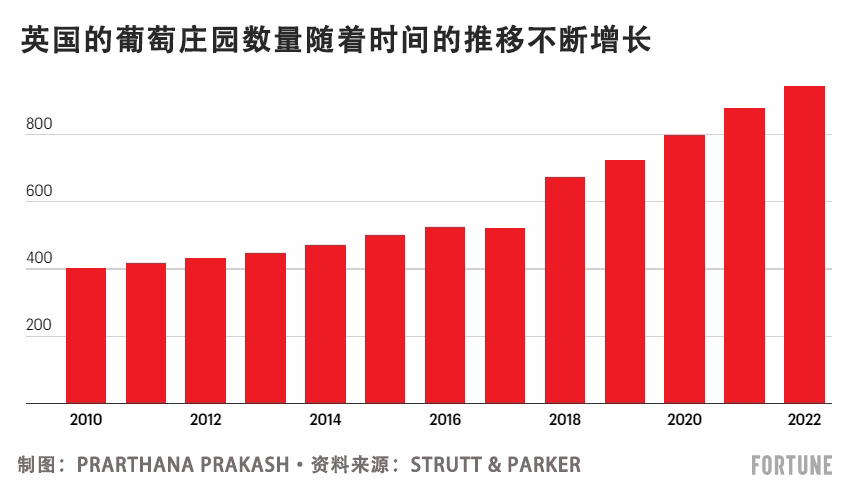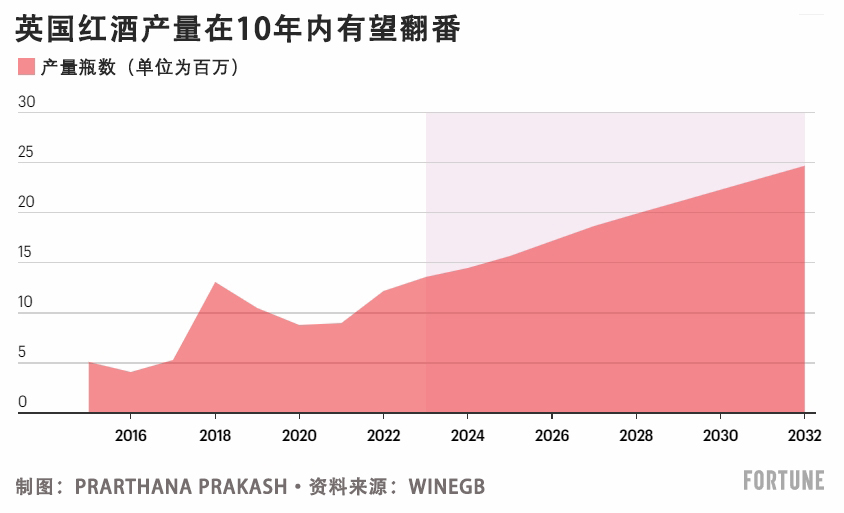
受气候变化影响,今年将成为历史上气温最高的一年,这一现象对于那些没有能力加大投入并采取行动规避的行业带来了巨大的冲击,例如葡萄酒酿造行业。由于极端天气影响了葡萄的产量和品质,在那些因为酿造全球知名葡萄酒而长期处于主导地位的产区,比如意大利,产酒量均出现了下滑。
在葡萄酒行业格局开始变化之际,有一个国家成为了出人意料的赢家。英国的葡萄种植历史十分悠久,有人估计,其种植史能够追溯至11世纪。然而,该国始终未能像其欧洲同行一样,提供更高品质、更多种类的葡萄酒,并借此跻身葡萄酒大国的阵营。英国并不怎么理想的葡萄酒种植环境是该现象背后的原因之一。
然而,随着全球温度的上升,英国的气候条件变得更加适合种植某些葡萄品种,也为该国处于扩张中的葡萄酒行业带来了机会。更暖和的天气让英国葡萄的成熟度更高,继而提升了葡萄酒的品质。
Gusbourne Estates的营销总监乔纳森·怀特在接受《财富》杂志采访时表示:“从历史上看,英国葡萄酒普及度并不高,而且口碑也不是很好。”Gusbourne Estates在肯特郡和西萨塞克斯郡有葡萄庄园。这些庄园有着近20年的葡萄种植史。
他说:“英国葡萄酒的品质往往并不是很好,而且也不是由专业酿酒人士或优秀和懂行的葡萄栽培者生产。”怀特还表示,不过,通过种植合适的葡萄品种组合,再加上更暖和的天气,英国葡萄酒酿酒行业又重新引起了业界的重视。
英国房地产咨询公司Strutt & Parker的葡萄种植负责人尼克·沃森在6月的一份报告里写道:“对英国葡萄酒行业的兴趣达到了有史以来的最高峰,在过去12个月中,我们收到的有意购买酒庄或设立新酒庄的电话数量是之前的三倍。”
该集团发现,英国葡萄庄园的数量在过去六年里增长了80%,达到了900多座,而葡萄栽种英亩数亦出现了类似的增幅。即使这一数字无法与欧盟的一些葡萄酒首要产区相比,但在这个长期以来被一众老牌强国所主导的行业中,英国正在开创自己的一片天地。

快速增长
气候变化对葡萄酒行业的影响是渐进式的,同时也是翻天覆地的。例如在法国,近几年来多变的天气模式一直在重塑着葡萄酒行业,也改变了所产葡萄的品质。今年10月,欧洲农业游说团体Copa-Cogeca发布的数据显示,葡萄牙和意大利的葡萄产量分别下滑了8.6%和11.92%。
(不过,不用担心葡萄短缺问题。长期以来,欧洲葡萄酒一直处于过剩状态,也就是“酒海”问题。今年,法国政府称,该国将耗费2亿美元来销毁过剩的葡萄酒,并把收益让渡给饱受葡萄酒价格和需求下跌折磨的酿酒商。)
尽管气候变化并不是什么好事情,但一些地区葡萄酒产量的缓慢下滑一直让英国受益匪浅。葡萄酒专家、咨询公司The Wine and Climate Change Institute的创始人琳达·约翰逊-贝尔告诉《财富》杂志,英国如今的气候与20世纪七八十年代的波尔多或香槟大区类似。
她在谈论当前的这些法国产区时表示:“如今,人们已经见惯不怪了,每个月都会出现一场新灾难。”
除了气候条件之外,法规的非正式性也为英国葡萄酒的扩张提供了助力。在葡萄酒生产方面,欧洲出台了具体的法规,包括酿造特定酒种所需使用的葡萄种类,以及气泡酒瓶应该使用哪类瓶塞。
Strutt & Parker的沃森对《财富》杂志表示:“我们并没有这些限制。”今年早些时候,英国表示将取消欧盟对葡萄酒酿造的要求,称这些要求扼杀了创新。此举或将为当地红酒经济带来1.8亿英镑的红利。
沃森说:“相对于从旧世界红酒产区的知名葡萄种植区购买土地而言,英国较好的种植土地更便宜。因此,从成本门槛角度以及高品质红酒酿造潜力来讲,这一点还是非常有吸引力的。”
行业协会WineGB的数据显示,英国温度的变化对某些葡萄品种的种植而言尤为有益,而霞多丽、黑皮诺和黑皮诺梅尼耶这三种用于制作传统香槟的葡萄在英国当前的种植面积最广。
雷丁大学(University of Reading)的生态系统科学教授马丁·卢卡茨告诉《财富》杂志:“随着气候的变化,优质气泡酒如今迎来了一波机遇。”他还指出,这对葡萄酒业界人士来说是一个赚钱的机会,因为气泡酒的利润率要高于非气泡酒。
卢卡茨称:“与任何行业一样,盈利是种植者生存的前提。”他还表示,近些年来,该行业的回报引发了人们的兴趣。WineGB预计,葡萄酒产量在未来十年将翻一番,从2022年的1,220万瓶增至2032年的2,470万瓶。

即便英国在主流红酒产业中基本上是一名新参与者,但它并没有选择角逐廉价或低品质红酒市场。The Wine and Climate Change Institute公司的约翰逊-贝尔对《财富》杂志表示,英国、苏格兰和威尔士酿酒商对超市红酒并不感兴趣。
她说:“其中很多都是精酿,他们并不希望酿造那种批量化的商业葡萄酒。”
Gusbourne便是其中一个例子,这个庄园始终奉行低产目标,以确保其葡萄酒品质不会下滑。
Gusbourne Estates的怀特称:“我们异常看重的一点在于,要让葡萄酒酿造成为一种以工艺为导向的艺术。该庄园30%的葡萄酒出口到了35个国际地区,包括挪威、日本和美国。英国如今也拥有多款获奖葡萄酒。”
注重每颗葡萄树的品质
经营葡萄酒酿制业务并非易事。在收获葡萄并将其转化为可供消费的葡萄酒之前,人们需要耗费数年的时间来看护葡萄树。沃森指出,这项工作还需要大量的资本投入,而且其成本还包括购买和管理数千英亩的土地,以确保其适合种植葡萄树。
他说:“一旦将这些标准叠加之后,实际上适合葡萄种植的区域要比人们想象的小得多。因此,它对现金流有着很大的要求,是一个异常烧钱的产业。”
作为英国葡萄酒行业增长的助推器,气候变化也在快速演变。围绕气候变化对葡萄酒生产的影响,约翰逊-贝尔在全球各地开展了多个项目,并发现了一个巨大的机遇窗口。不过,有鉴于快速演变的气候变化,这个窗口也在不断转变。
她说:“这里最大的问题在于,适合种植某种葡萄品种的窗口期越来越短。”她补充道,她一直在建议客户种植可以适应更暖和天气的葡萄品种。“真正的问题在于如何在这一行业中未雨绸缪。”
尽管存在这些障碍,英国葡萄酒目前却迎来了前所未有的黄金期。葡萄酒出口以及外国对英国葡萄酒行业的兴趣一直在稳步增长,而英国葡萄酒行业的知名度亦是如此。
沃森说:“英国葡萄种植业的专业化水平、资本化水平以及投资规模都有了显著提升。”随着葡萄酒产量持续受益于气候条件的助力,英国葡萄酒行业有望一路高歌。“我们如今已经完全有能力大批量生产高品质葡萄。”(财富中文网)
译者:冯丰
审校:夏林
受气候变化影响,今年将成为历史上气温最高的一年,这一现象对于那些没有能力加大投入并采取行动规避的行业带来了巨大的冲击,例如葡萄酒酿造行业。由于极端天气影响了葡萄的产量和品质,在那些因为酿造全球知名葡萄酒而长期处于主导地位的产区,比如意大利,产酒量均出现了下滑。
在葡萄酒行业格局开始变化之际,有一个国家成为了出人意料的赢家。英国的葡萄种植历史十分悠久,有人估计,其种植史能够追溯至11世纪。然而,该国始终未能像其欧洲同行一样,提供更高品质、更多种类的葡萄酒,并借此跻身葡萄酒大国的阵营。英国并不怎么理想的葡萄酒种植环境是该现象背后的原因之一。
然而,随着全球温度的上升,英国的气候条件变得更加适合种植某些葡萄品种,也为该国处于扩张中的葡萄酒行业带来了机会。更暖和的天气让英国葡萄的成熟度更高,继而提升了葡萄酒的品质。
Gusbourne Estates的营销总监乔纳森·怀特在接受《财富》杂志采访时表示:“从历史上看,英国葡萄酒普及度并不高,而且口碑也不是很好。”Gusbourne Estates在肯特郡和西萨塞克斯郡有葡萄庄园。这些庄园有着近20年的葡萄种植史。
他说:“英国葡萄酒的品质往往并不是很好,而且也不是由专业酿酒人士或优秀和懂行的葡萄栽培者生产。”怀特还表示,不过,通过种植合适的葡萄品种组合,再加上更暖和的天气,英国葡萄酒酿酒行业又重新引起了业界的重视。
英国房地产咨询公司Strutt & Parker的葡萄种植负责人尼克·沃森在6月的一份报告里写道:“对英国葡萄酒行业的兴趣达到了有史以来的最高峰,在过去12个月中,我们收到的有意购买酒庄或设立新酒庄的电话数量是之前的三倍。”
该集团发现,英国葡萄庄园的数量在过去六年里增长了80%,达到了900多座,而葡萄栽种英亩数亦出现了类似的增幅。即使这一数字无法与欧盟的一些葡萄酒首要产区相比,但在这个长期以来被一众老牌强国所主导的行业中,英国正在开创自己的一片天地。
快速增长
气候变化对葡萄酒行业的影响是渐进式的,同时也是翻天覆地的。例如在法国,近几年来多变的天气模式一直在重塑着葡萄酒行业,也改变了所产葡萄的品质。今年10月,欧洲农业游说团体Copa-Cogeca发布的数据显示,葡萄牙和意大利的葡萄产量分别下滑了8.6%和11.92%。
(不过,不用担心葡萄短缺问题。长期以来,欧洲葡萄酒一直处于过剩状态,也就是“酒海”问题。今年,法国政府称,该国将耗费2亿美元来销毁过剩的葡萄酒,并把收益让渡给饱受葡萄酒价格和需求下跌折磨的酿酒商。)
尽管气候变化并不是什么好事情,但一些地区葡萄酒产量的缓慢下滑一直让英国受益匪浅。葡萄酒专家、咨询公司The Wine and Climate Change Institute的创始人琳达·约翰逊-贝尔告诉《财富》杂志,英国如今的气候与20世纪七八十年代的波尔多或香槟大区类似。
她在谈论当前的这些法国产区时表示:“如今,人们已经见惯不怪了,每个月都会出现一场新灾难。”
除了气候条件之外,法规的非正式性也为英国葡萄酒的扩张提供了助力。在葡萄酒生产方面,欧洲出台了具体的法规,包括酿造特定酒种所需使用的葡萄种类,以及气泡酒瓶应该使用哪类瓶塞。
Strutt & Parker的沃森对《财富》杂志表示:“我们并没有这些限制。”今年早些时候,英国表示将取消欧盟对葡萄酒酿造的要求,称这些要求扼杀了创新。此举或将为当地红酒经济带来1.8亿英镑的红利。
沃森说:“相对于从旧世界红酒产区的知名葡萄种植区购买土地而言,英国较好的种植土地更便宜。因此,从成本门槛角度以及高品质红酒酿造潜力来讲,这一点还是非常有吸引力的。”
行业协会WineGB的数据显示,英国温度的变化对某些葡萄品种的种植而言尤为有益,而霞多丽、黑皮诺和黑皮诺梅尼耶这三种用于制作传统香槟的葡萄在英国当前的种植面积最广。
雷丁大学(University of Reading)的生态系统科学教授马丁·卢卡茨告诉《财富》杂志:“随着气候的变化,优质气泡酒如今迎来了一波机遇。”他还指出,这对葡萄酒业界人士来说是一个赚钱的机会,因为气泡酒的利润率要高于非气泡酒。
卢卡茨称:“与任何行业一样,盈利是种植者生存的前提。”他还表示,近些年来,该行业的回报引发了人们的兴趣。WineGB预计,葡萄酒产量在未来十年将翻一番,从2022年的1,220万瓶增至2032年的2,470万瓶。
即便英国在主流红酒产业中基本上是一名新参与者,但它并没有选择角逐廉价或低品质红酒市场。The Wine and Climate Change Institute公司的约翰逊-贝尔对《财富》杂志表示,英国、苏格兰和威尔士酿酒商对超市红酒并不感兴趣。
她说:“其中很多都是精酿,他们并不希望酿造那种批量化的商业葡萄酒。”
Gusbourne便是其中一个例子,这个庄园始终奉行低产目标,以确保其葡萄酒品质不会下滑。
Gusbourne Estates的怀特称:“我们异常看重的一点在于,要让葡萄酒酿造成为一种以工艺为导向的艺术。该庄园30%的葡萄酒出口到了35个国际地区,包括挪威、日本和美国。英国如今也拥有多款获奖葡萄酒。”
注重每颗葡萄树的品质
经营葡萄酒酿制业务并非易事。在收获葡萄并将其转化为可供消费的葡萄酒之前,人们需要耗费数年的时间来看护葡萄树。沃森指出,这项工作还需要大量的资本投入,而且其成本还包括购买和管理数千英亩的土地,以确保其适合种植葡萄树。
他说:“一旦将这些标准叠加之后,实际上适合葡萄种植的区域要比人们想象的小得多。因此,它对现金流有着很大的要求,是一个异常烧钱的产业。”
作为英国葡萄酒行业增长的助推器,气候变化也在快速演变。围绕气候变化对葡萄酒生产的影响,约翰逊-贝尔在全球各地开展了多个项目,并发现了一个巨大的机遇窗口。不过,有鉴于快速演变的气候变化,这个窗口也在不断转变。
她说:“这里最大的问题在于,适合种植某种葡萄品种的窗口期越来越短。”她补充道,她一直在建议客户种植可以适应更暖和天气的葡萄品种。“真正的问题在于如何在这一行业中未雨绸缪。”
尽管存在这些障碍,英国葡萄酒目前却迎来了前所未有的黄金期。葡萄酒出口以及外国对英国葡萄酒行业的兴趣一直在稳步增长,而英国葡萄酒行业的知名度亦是如此。
沃森说:“英国葡萄种植业的专业化水平、资本化水平以及投资规模都有了显著提升。”随着葡萄酒产量持续受益于气候条件的助力,英国葡萄酒行业有望一路高歌。“我们如今已经完全有能力大批量生产高品质葡萄。”(财富中文网)
译者:冯丰
审校:夏林
We’re set to clock in the warmest year on record, thanks to climate change, and that’s had a major impact on industries that can’t up stakes and move to avoid it—like the winemaking business. Regions that have long been at the helm of fermenting globally renowned wines, such as Italy, have seen volumes drop due to extreme weather impacting grape yields and quality.
As dynamics in the wine industry begin to change, one country has become a surprise winner. Britain has had a long viticulture history, some estimates going back to the 11th century. Still, it never rose up the ranks as a wine capital alongside its European peers, which offered higher quality and more variety—and Britain’s less-than-ideal grape-growing weather was one reason why.
As global temperatures have increased, however, the conditions in the U.K. have become better-suited to grow certain grape varieties, paving the way for a sprawling winemaking industry. Warmer temperatures have enabled better ripening of Britain’s grapes and therefore, better qualities of wine.
“Historically, English wine hasn’t had a very popular or positive reputation,” Jonathan White, marketing director at Gusbourne Estates, which has vineyards in Kent and West Sussex, told Fortune in an interview. The property planted its first vines nearly two decades ago.
“The wine just typically wasn’t very good and wasn’t produced by wine professionals and fantastic viticulturists and viticulturalists who knew what they were doing,” he said. But, White added, planting the right mix of grape varieties, with help from warmer temperatures, has given the winemaking business its new-found fame.
“Interest in the British wine sector is as strong as we can remember–over the past 12 months the number of calls we have received from people interested in either buying a vineyard or establishing a new one has tripled,” Nick Watson, the head of viticulture at Strutt & Parker, a U.K.-based real estate advisory, wrote in a June report.
The number of vineyards in the country have risen by 80% in the last six years to over 900, while the acres in production have seen a similar growth, the group found. Even though that dwarfs in comparison to some of the EU’s wine capitals, Britain is carving out a space for itself in an industry long dominated by the historic hubs.
Boom and bloom
The impact of climate change on the wine industry has been gradual, yet significant. In France, for instance, erratic weather patterns have been reshaping the wine industry for a few years now, altering the quality of grapes yielded. And last month, data published by Copa-Cogeca, a European farming lobby, saw wine harvests drop 8.6% and 11.92% in Portugal and Italy, respectively.
(Don't worry about wine shortages, though. There is a long-standing glut of European wine, known as the "wine lake". This year, the French government said it will set aside $200 million to destroy excess wine and offer the proceeds to producers amid collapsing prices and falling wine demand.)
While climate change is nothing to celebrate, the slow decline in wine production in some regions has been Britain’s gain. Linda Johnson-Bell, a wine expert and the founder of consultancy The Wine and Climate Change Institute (TWACCI), told Fortune that Britain’s climate now resembles that of Bordeaux or Champagne in the 1970s and 1980s.
“Now, it’s just a potluck, every month brings a new disaster,” she said in reference to those French regions today.
Aside from climate conditions, the informal nature of regulation has helped the British wine industry expand. Europe follows specific regulations governing the production of wine, including the type of varieties that need to be used to make specific formulations and the use of certain caps on sparkling wine bottles.
“We don't have those constraints,” Strutt & Parker's Watson told Fortune. Earlier this year, the U.K. said it would cut out the EU requirements on wine production, which it said were stifling innovation, and it could unlock £180 million in the local wine economy.
“Good planting land is relatively cheaper than it is to buy in the established wine growing regions of the old-world wine producers. So, it's quite attractive from the point of view of cost of entry and the potential to produce good quality wine,” Watson said.
The shift in temperature in the U.K. has been especially helpful for growing some varieties, and Chardonnay, Pinot Noir and Pinot Meunier—the three grapes used to make traditional Champagne—are currently Britain's most-planted, according to data from industry body WineGB.
“As the climate changes there’s an opportunity right now for excellent sparkling wine,” Martin Lukac, professor of ecosystem science at the University of Reading, told Fortune. He added that this has been lucrative for those in the winemaking business as margins are higher in the sparkling varieties over their still counterparts.
“Farmers are the same as any other business; they have to make a profit in order to sustain their livelihood,” said Lukac, adding that the returns have piqued interest in recent years. WineGB expects wine production to double in the next 10 years from 12.2 million bottles in 2022 to 24.7 million in 2032.
Even though the U.K. is a fairly new player in the mainstream wine industry, it doesn’t compete in the market for cheap or low-quality varieties of the drink. TWACCI's Johnson-Bell told Fortune that winemakers in England, Scotland and Wales are not interested in supermarket wines.
“A lot of them are artisanal, they don’t want to do mass-produced, commercial [wine],” she said.
Gusbourne is one example—the estate keeps its yield targeted and low to ensure the quality of wine isn’t compromised.
“We're very focused on the art of winemaking being really craft-led,” Gusbourne Estates's White said, adding that Gusbourne valued quality over quantity. The estate exports about 30% of its wines to 35 international territories including Norway, Japan, and the U.S. Britain is now also home to several award-winning wines.
Making every vine count
Being in the wine business is no easy feat—it takes years of tending to vines before their grapes can be harvested and turned into the alcohol ready to consume. The work is also incredibly capital intensive, Watson points out, and involves expenses including the buying and managing thousands of acres of land to make sure it's suitable to grow vines.
“By the time you overlay all these criteria, actually the areas that are perfect for viticulture are quite a lot smaller than one would imagine,” he said. “So the cash flow is very demanding and therefore it's quite an expensive business to get into.”
The phenomenon catalyzing the British wine industry's growth—climate change—is fast evolving. Johnson-Bell, who works on projects internationally surrounding climate change’s impact on wine production, sees a huge window of opportunity, but also one that’s shifting given the rapid pace of climate change.
“The biggest problem here is that the window during which a grape variety is viable is getting shorter and shorter,” she said, adding that she’s been advising clients to grow grape varieties that can adapt to warmer weather. “The real issue will be how to future-proof this industry.”
Despite these hurdles, British wine is in a better place than it’s ever been. Exports and foreign interest have been steadily growing—as has recognition for the industry.
“The U.K. viticulture has become a much more professional, well capitalized, well invested business,” Watson said. And as the weather conditions continue to provide fruitful wine yields, the industry looks poised to flourish. “We are now very capable of producing excellent quantity of quality grapes.”






